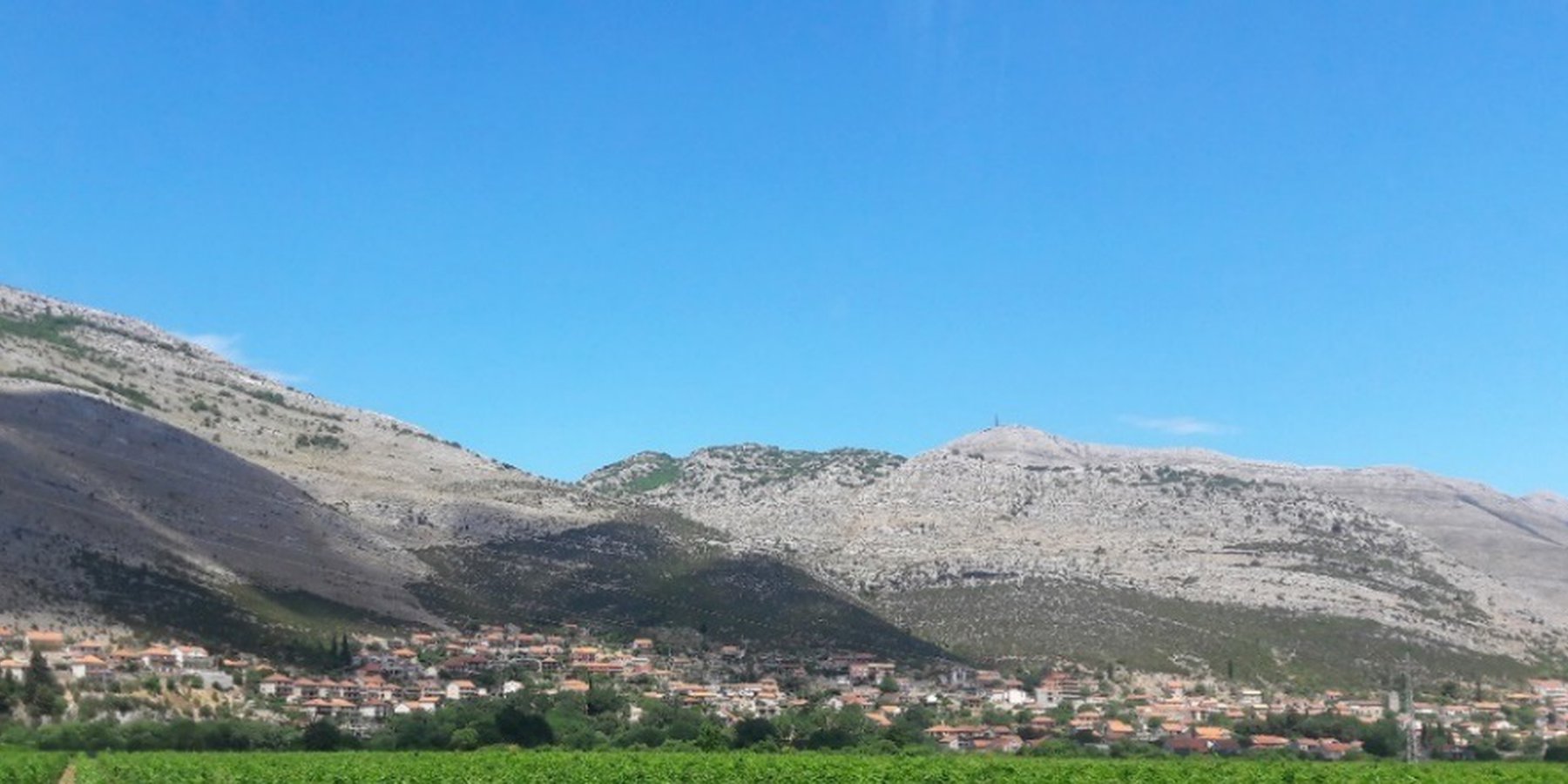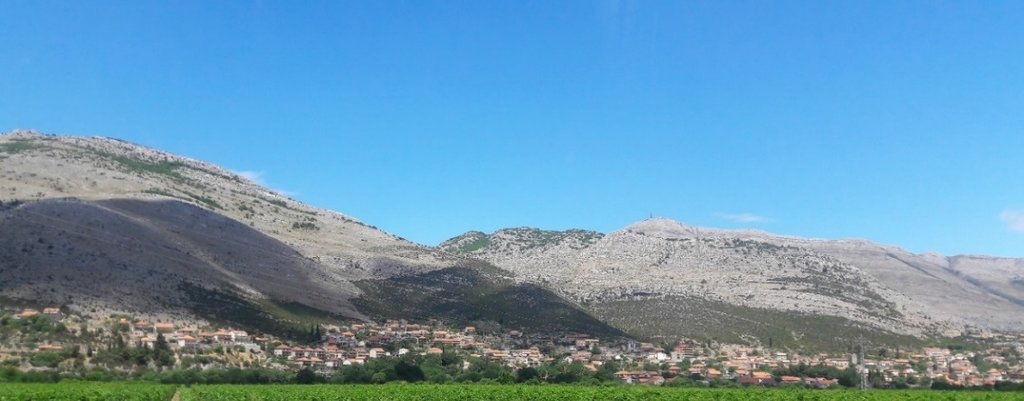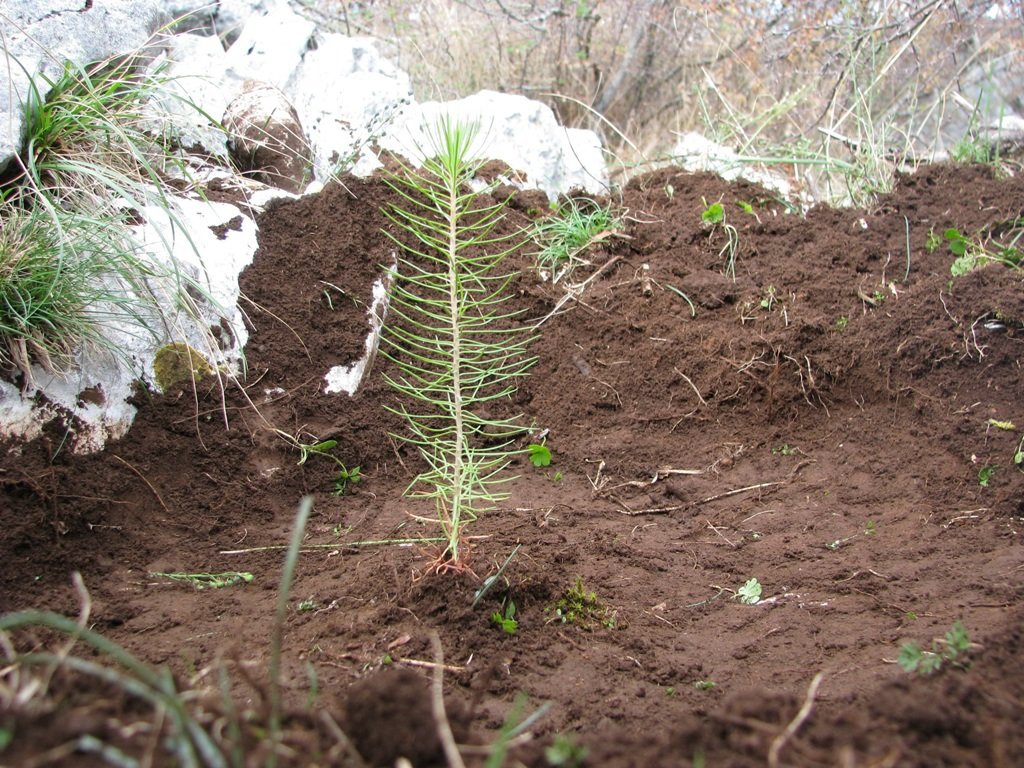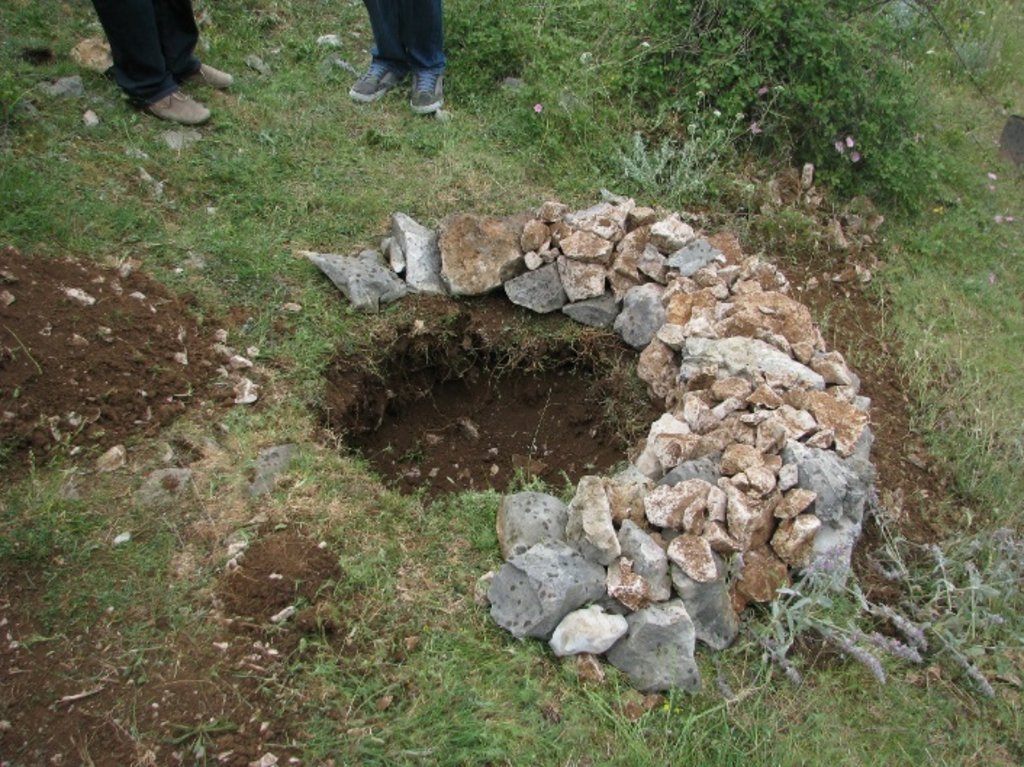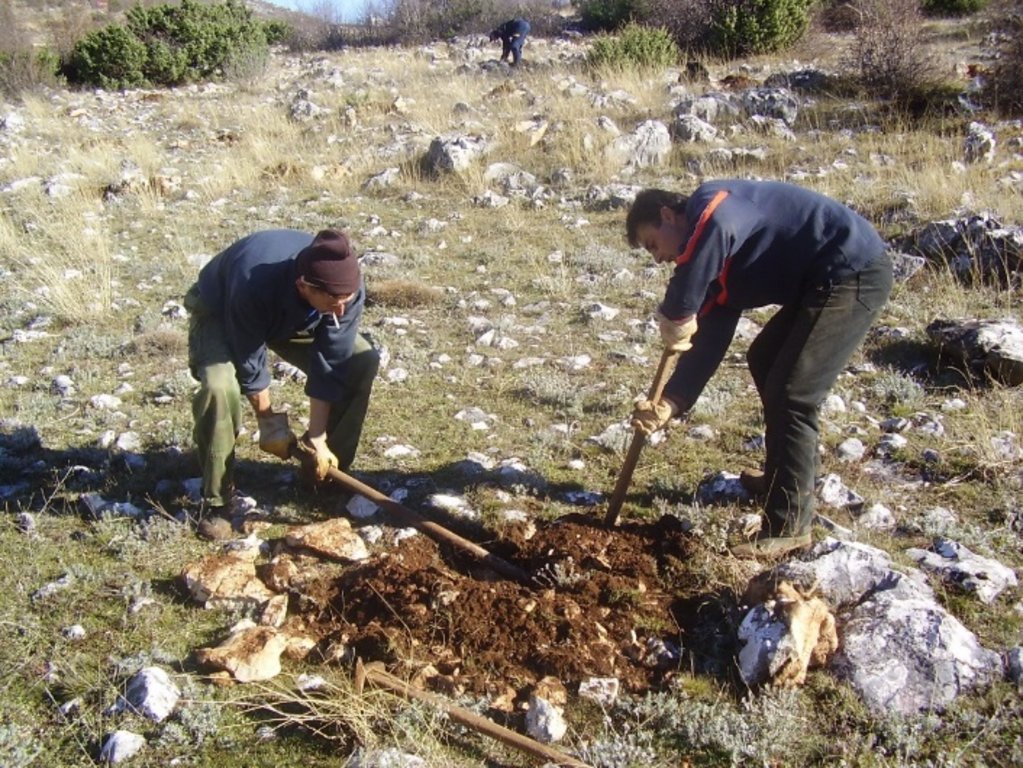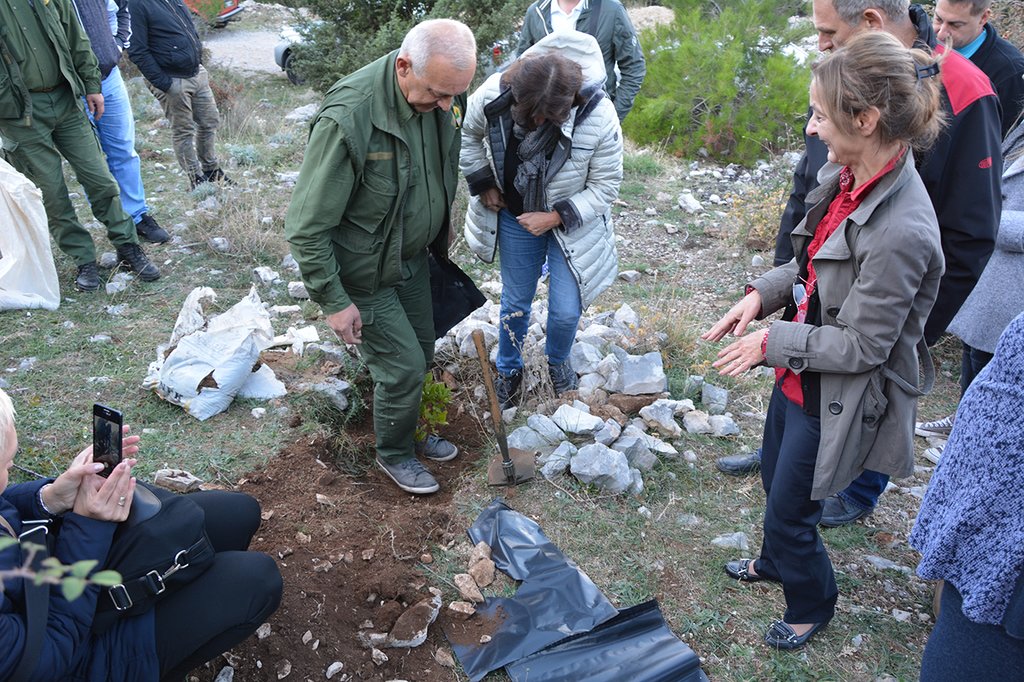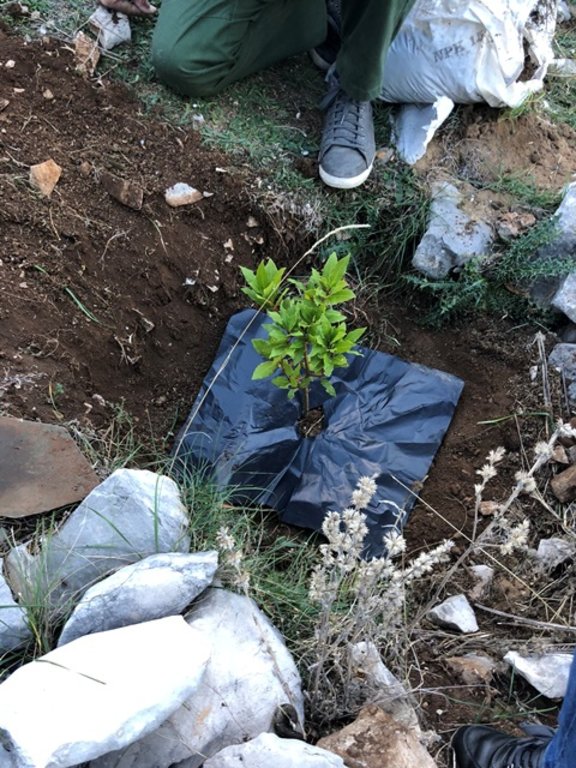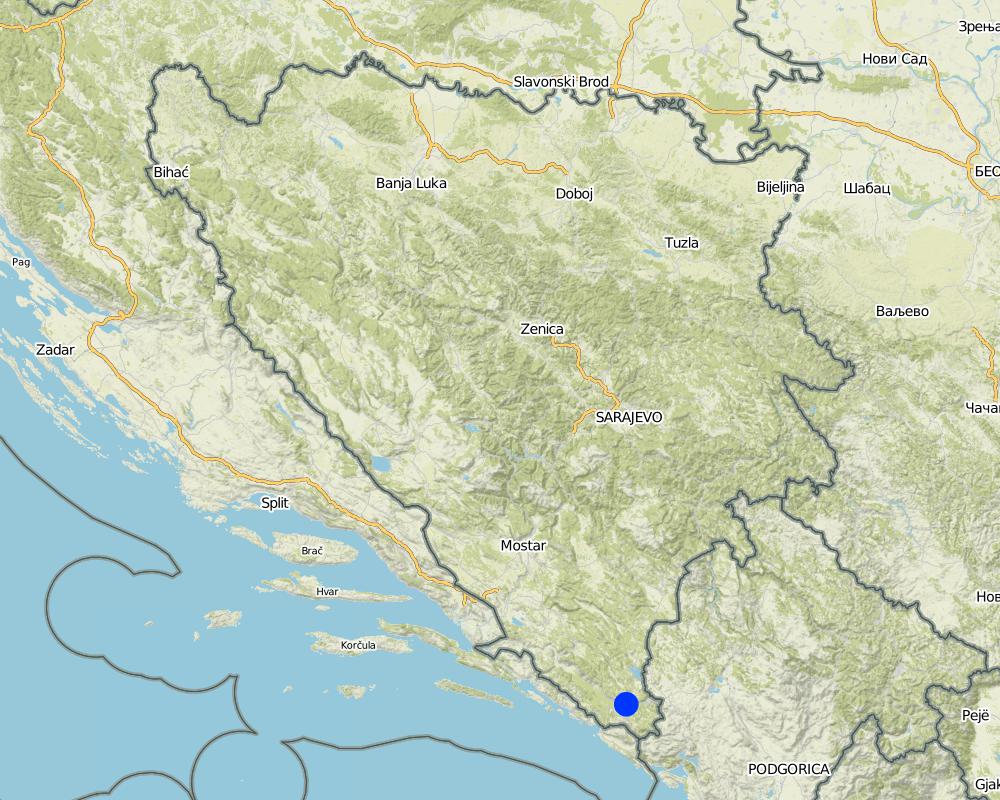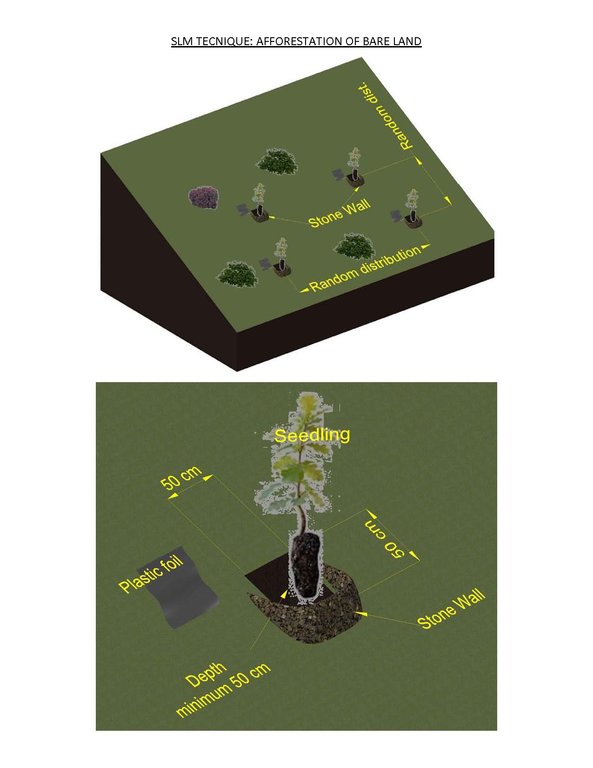Afforestation of bare land in karst areas [Bósnia e Herzegovina]
- Criação:
- Atualização:
- Compilador/a: Marijana Kapović Solomun
- Editor: –
- Revisor: THEODORA FETSI
Pošumljavanje goleti
technologies_4367 - Bósnia e Herzegovina
Veja as seções
Expandir tudo Recolher tudo1. Informação geral
1.2 Detalhes do contato das pessoas capacitadas e instituições envolvidas na avaliação e documentação da tecnologia
Pessoa(s) capacitada(s)
usuário de terra:
Vasiljević Mirela
Center for Karst Management
Bósnia e Herzegovina
Nome do projeto que facilitou a documentação/avaliação da Tecnologia (se relevante)
Decision Support for Mainstreaming and Scaling out Sustainable Land Management (GEF-FAO / DS-SLM)Nome da(s) instituição(ões) que facilitou(ram) a documentação/ avaliação da Tecnologia (se relevante)
University of Banja Luka (UNIBL) - Bósnia e Herzegovina1.3 Condições em relação ao uso da informação documentada através de WOCAT
O/a compilador/a e a(s) pessoa(s) capacitada(s) aceitam as condições relativas ao uso de dados documentados através da WOCAT:
Sim
1.4 Declaração de sustentabilidade da tecnologia descrita
A tecnologia descrita aqui é problemática em relação a degradação da terra de forma que não pode ser declarada uma tecnologia de gestão sustentável de terra?
Não
1.5 Referência ao(s) questionário(s) sobre abordagens GST (documentado(s) usando WOCAT)
2. Descrição da tecnologia de GST
2.1 Descrição curta da tecnologia
Definição da tecnologia:
Afforestation of bare land in Herzegovina region, a vulnerable area characterized by Karst landscapes, is an SLM technique aimed to increase water-holding capacity and reduce land degradation
2.2 Descrição detalhada da tecnologia
Descrição:
The afforestation of bare land is a very important SLM technique, which is mainly applied in the southern part of the Republika Srpska (Bosnia and Herzegovina), but also in other parts of the country where bare land is widespread. The southern part of the country,Herzegovina, is ecologically very vulnerable and characterized by the dominance of limestone-dolomite rocks, with shallow and poorly developed soils, water deficiency over vegetation period and poor water regime, which is an additional aggravating factor for successful afforestation. Under such conditions, afforestation is the most widely used SLM measure in the area, which is characterized by karst landscapes. Namely, since 1950, there was a combination of vegetation and technical measures that would increase the chances of success when reforesting Herzegovina's bare land.
Bare land is a result of the natural features of the given region, but very often is exacerbated by unsustainable forest management, and frequent fires that have an impact on vegetation cover. This creates preconditions for soil erosion and contamination of drinking water springs. Afforestation of bare land is applied throughout the territory of Herzegovina, but mainly on forestland and public owned areas. The specificity of the natural conditions of the Herzegovinian karst, greatly reduces the range of plant species that could be considered suitable for afforestation. Also, limestone-dolomite soils are usually shallow, dry and xero-termophilic and require irrigation to increase success. However, irrigation is still not being applied on forestland, therefore forest managers use other possible measures that could reduce the water deficit in the first years of plant life, including afforestation
The Karst Management Center (under the jurisdiction of the Public Forest Enterprize “Šume Republike Srpske” and Ministry of Agriculture, Forestry and Water Management), is located in Trebinje, and manages the forests and forest land of six municipalities in Herzegovina . Every year, as part of the regular forest/karst management measures, bare land is afforested, using plant species produced in forest nurseries of the Republika Srpska. The most used ones are Pinus nigra, Pinus halepensis and Cupressus sempervirens. The newly established forest nursery in Trebinje, is consisted of ecologically adapted species to Mediterranean conditions, which constitutes a step forward to increase success of afforestation. Plants are produced in containers whose root system is coated with high quality substrate and protected by plastic foil.
The basic characteristic of the SLM measure “afforestation on bare land” is the deeper holes that need to be dug in comparison to a “regular” afforestation. The dimensions of the holes are 50x50x50cm. Due to the unfavourable conditions (high level of rockiness, shallow soils, steep slopes, water deficit etc.), it is possible to plant maximum up to 1400 plants per hectare. A low-height stonewall is being built around the hole of the tree at the lower part of the mountain, so it can retain the water from the upper parts, reduce degradation and retain soil moisture.This is particularly important for steeper slopes where it is essential to conserve soil and water for improved growth of trees and other vegetation. After putting the seedlings into the holes, soil is being put around the root system, and polyvinyl foil is being placed in funnel form, to collect rainwater and create a compact compound of the substrate in the touching zone with the soil around the root.
The best period for afforestation in Herzegovina is October and November. The technology requires manual work due to level of rockiness and steep slopes, which does not allow any use of machines. Planting seedlings is favorable during autumn due to soil compression after the rainfall of September when the contact between the holes and the substratum is fully established. This is especially important for plant resistance against drought, which lead to physiological weakness. Planting seedlings at the beginning of March is favorable only in cases when no drought occurs immediately after planting. This is possible only in the more continental part of the Karst area. When planting a tree, it is important to bear in mind that wind erosion can occur. Therefore, the substrate should be placed below the surface of the soil in the holes, especially if the planting is carried out immediately after the first rainfall followed by a warm summer period. This is a traditional technique of karst and bare land management, but new species better adapted to the landscape have been recently introduced.
2.3 Fotos da tecnologia
2.5 País/região/locais onde a tecnologia foi aplicada e que estão cobertos nesta avaliação
País:
Bósnia e Herzegovina
Região/Estado/Província:
Republic of Srpska
Especificação adicional de localização:
Trebinje Municipality
Especifique a difusão da tecnologia:
- Uniformemente difundida numa área
Se a Tecnologia estiver uniformemente distribuída por uma área, especifique a área coberta (em km2):
1,0
Se a área precisa não for conhecida, indicar a área aproximada coberta:
- 1-10 km2
O(s) local(is) tecnológico(s) está(ão) localizado(s) em uma área permanentemente protegida?
Não
Map
×2.6 Data da implementação
Caso o ano exato seja desconhecido, indique a data aproximada:
- menos de 10 anos atrás (recentemente)
2.7 Introdução da tecnologia
Especifique como a tecnologia foi introduzida:
- Como parte do sistema tradicional (>50 anos)
3. Classificação da tecnologia de GST
3.1 Principal/principais finalidade(s) da tecnologia
- Reduz, previne, recupera a degradação do solo
- Preserva ecossistema
- Protege uma bacia/zonas a jusante – em combinação com outra tecnologia
- Reduzir riscos de desastre
- Adaptar a mudanças climáticas/extremos e seus impactos
- Atenuar a mudanças climáticas e seus impactos
- Cria impacto social benéfico
3.2 Tipo(s) atualizado(s) de uso da terra onde a tecnologia foi aplicada
Uso do solo misturado dentro da mesma unidade de terra:
Sim
Especificar o uso misto da terra (culturas/ pastoreio/ árvores):
- Agrofloresta

Floresta/bosques
- Florestas/bosques (semi)naturais
Florestas (semi)naturais/ bosques: Especificar o tipo de manejo:
- Uso florestal não madeireiro
As árvores especificadas acima são decíduas ou perenes?
- decíduas mistas/perene
Produtos e serviços:
- Outros produtos florestais
- Conservação/proteção da natureza
- Proteção contra desastres naturais

Terra improdutiva
Especifique:
Bare land with shallow soils vulnerable to erosion and expressed water deficiency over vegetation period.
Observações:
Vegetation is presented by bushes, scarce forest of low quality, exposed to fire, drought and erosion.
3.3 O uso do solo mudou devido à implementação da Tecnologia?
O uso do solo mudou devido à implementação da Tecnologia?
- Não (Continuar com a pergunta 3.4)
Uso do solo misturado dentro da mesma unidade de terra:
Não
3.4 Abastecimento de água
Abastecimento de água para a terra na qual a tecnologia é aplicada:
- Precipitação natural
3.5 Grupo de GST ao qual pertence a tecnologia
- Gestão natural e seminatural de floresta
- Solo/cobertura vegetal melhorada
- Medidas de curva de nível
3.6 Medidas de GST contendo a tecnologia

Medidas vegetativas
- V1: cobertura de árvores/arbustos
- V2: gramíneas e plantas herbáceas perenes

Medidas estruturais
- S6: Muros, barreiras, paliçadas, cercas
3.7 Principais tipos de degradação da terra abordados pela tecnologia

Erosão do solo pela água
- Wt: Perda do solo superficial/erosão de superfície
- Wo: efeitos de degradação externa

Degradação biológica
- Bc: redução da cobertura vegetal
- Bq: quantidade/ declínio da biomassa
- Bf: efeitos prejudiciais de incêndios
- Bl: perda da vida do solo
3.8 Redução, prevenção ou recuperação da degradação do solo
Especifique o objetivo da tecnologia em relação a degradação da terra:
- Recuperar/reabilitar solo severamente degradado
- Adaptar à degradação do solo
4. Especificações técnicas, implementação de atividades, entradas e custos
4.1 Desenho técnico da tecnologia
Especificações técnicas (relacionada ao desenho técnico):
The natural conditions of the Herzegovinian karst greatly reduce the range of plant species that could be considered for afforestation. Also, limestone-dolomite soils are usually shallow, dry and xero-termophilic and require irrigation to increase success. Container seedlings whose root system is coated with high quality substrate and protected by plastic foil have been used for afforestation.
The dimensions of each hole are 50x50x50cm. Due to the unfavorable conditions (high level of rockiness, shallow soils, steep slopes, water deficit etc.), around 1150-1400 trees can be planted per hectare. This technology requires manual work, without any use of machines, due to steep slopes and high rockiness. A stone wall is being built at the lower part of the mountain which acts as a barrier. . The role of this barrier is to slow down the water movement down the slope and retain the soil moisture. After having planted the tree polyvinyl foil has been placed in funnel form, to collect rain and create a compact compound of the substrate in the touching zone with the soil around the root. For the Herzegovina area, the best time for afforestation is October and November.
Afforested plants have to be protected from animals at least for the first 3 years. Also, fertilization is applied once per year and mechanic weed control techniques are used for plant protection and treatment of soil surface.
Autor:
Marijana Kapović Solomun and Mirela Vasiljević
4.2 Informação geral em relação ao cálculo de entradas e custos
Especifique como custos e entradas foram calculados:
- por área de tecnologia
Indique o tamanho e a unidade de área:
per 1 hectare
Outro/moeda nacional (especifique):
BAM
Se for relevante, indique a taxa de câmbio do USD para moeda local (por exemplo, 1 USD = 79,9 Real): 1 USD =:
1,65
4.3 Atividades de implantação
| Atividade | Periodicidade (estação do ano) | |
|---|---|---|
| 1. | Preparation work (planning of possible places for afforestation) | September |
| 2. | Digging of holes for plants | September-October |
| 3. | Collecting the stones from the spot and building stone wall | September-October |
| 4. | Afforestation-planting trees | October-November |
| 5. | Fertilization of afforested plants | After afforestation |
| 6. | Metal fences construction for protection from animals | After afforestation (in the first 3 years of life) |
| 7. | Re-afforestation | After first afforestation (where it is not successful) |
| 8. | Re-fertilization | For re-afforested plants (once) |
4.4 Custos e entradas necessárias para a implantação
| Especifique a entrada | Unidade | Quantidade | Custos por unidade | Custos totais por entrada | % dos custos arcados pelos usuários da terra | |
|---|---|---|---|---|---|---|
| Mão-de-obra | Preparation work (planning of possible places for afforestation) | hectare | 1,0 | 100,0 | 100,0 | |
| Mão-de-obra | Digging of holes for plants, collecting the stones from the spot and creation stone wall | hectare | 1,0 | 400,0 | 400,0 | |
| Mão-de-obra | Afforestation+re-afforestation | hectare | 1,0 | 1150,0 | 1150,0 | |
| Mão-de-obra | Fertilization+weed protection+construction of metal fences | hectare | 1,0 | 1250,0 | 1250,0 | |
| Equipamento | Polyvinyl foil | per seedling | 1,0 | 1,0 | 1,0 | |
| Material vegetal | Afforestation + re-afforestation (plant seedlings) | hectare | 3,0 | 2150,0 | 6450,0 | |
| Fertilizantes e biocidas | Fertlization (fertilizers) | hectare | 1,0 | 145,0 | 145,0 | |
| Material de construção | Protection from animals (costs of metal fences) | hectare | 1,0 | 529,0 | 529,0 | |
| Outros | Transportation costs | kilometer | 1,0 | 5,0 | 5,0 | |
| Custos totais para a implantação da tecnologia | 10030,0 | |||||
| Custos totais para o estabelecimento da Tecnologia em USD | 6078,79 | |||||
4.5 Atividades recorrentes/manutenção
| Atividade | Periodicidade/frequência | |
|---|---|---|
| 1. | Repair/maintenance of metal fences | Over the year |
Comentários:
All costs of maintenance are included in costs needed for establishment.
4.6 Custos e entradas necessárias pata a manutenção/atividades recorrentes (por ano)
| Especifique a entrada | Unidade | Quantidade | Custos por unidade | Custos totais por entrada | % dos custos arcados pelos usuários da terra | |
|---|---|---|---|---|---|---|
| Mão-de-obra | Maintenance/repair of fences | hectare | 1,0 | 350,0 | 350,0 | |
| Material de construção | Cost of fences | hectare | 1,0 | 350,0 | 350,0 | |
| Custos totais para a manutenção da tecnologia | 700,0 | |||||
| Custos totais de manutenção da Tecnologia em USD | 424,24 | |||||
4.7 Fatores mais importantes que afetam os custos
Descreva os fatores mais determinantes que afetam os custos:
Character of terrain planned for afforestation, costs of labour and plant material. Prices are different every year.
5. Ambiente natural e humano
5.1 Clima
Precipitação pluviométrica anual
- <250 mm
- 251-500 mm
- 501-750 mm
- 751-1.000 mm
- 1.001-1.500 mm
- 1.501-2.000 mm
- 2.001-3.000 mm
- 3.001-4.000 mm
- > 4.000 mm
Especificações/comentários sobre a pluviosidade:
The average annual rainfall is 1680 mm, but with a very unfavorable schedule over the year.Over 60% of precipitation falls in the winter, outside of vegetation period and agriculture production. Only 40% is available for plants from April to September, and drought is very frequent.
Indique o nome da estação meteorológica de referência considerada:
Trebinje
Zona agroclimática
The climate in low Herzegovina region, particularly in Trebinje is Mediterranean with short mild winters and long hot summers. The Autumn is much warmer than spring, and snow is very rare. The highest recorded temperature was 42.5°C on July 22, 2007. The lowest recorded temperature was -9.6 °C, January 9, 2017.
5.2 Topografia
Declividade média:
- Plano (0-2%)
- Suave ondulado (3-5%)
- Ondulado (6-10%)
- Moderadamente ondulado (11-15%)
- Forte ondulado (16-30%)
- Montanhoso (31-60%)
- Escarpado (>60%)
Formas de relevo:
- Planalto/planície
- Cumes
- Encosta de serra
- Encosta de morro
- Sopés
- Fundos de vale
Zona de altitude:
- 0-100 m s.n.m.
- 101-500 m s.n.m.
- 501-1.000 m s.n.m.
- 1.001-1.500 m s.n.m.
- 1.501-2.000 m s.n.m.
- 2.001-2.500 m s.n.m.
- 2.501-3.000 m s.n.m.
- 3.001-4.000 m s.n.m.
- > 4.000 m s.n.m.
Indique se a tecnologia é aplicada especificamente em:
- Não relevante
5.3 Solos
Profundidade do solo em média:
- Muito raso (0-20 cm)
- Raso (21-50 cm)
- Moderadamente profundo (51-80 cm)
- Profundo (81-120 cm)
- Muito profundo (>120 cm)
Textura do solo (solo superficial):
- Grosso/fino (arenoso)
Textura do solo (>20 cm abaixo da superfície):
- Médio (limoso, siltoso)
Matéria orgânica do solo superficial:
- Médio (1-3%)
5.4 Disponibilidade e qualidade de água
Disponibilidade de água de superfície:
Precário/nenhum
Qualidade da água (não tratada):
Água potável boa
A qualidade da água refere-se a:
tanto de águas subterrâneas quanto de superfície
A salinidade da água é um problema?
Não
Ocorre inundação da área?
Sim
Regularidade:
Esporadicamente
Comentários e outras especificações sobre a qualidade e a quantidade da água:
Herzegovina area is characterized as a Karst region, with hilly topography, and flat areas with highly productive fields. Soil erosion is very frequent due to low vegetation cover in hilly areas, and frequent forest fires which destroy vegetation and soils. Drinking water resources are also endangered and sometimes polluted after heavy rains and fires. On the other hand, floods occur on the lower and more productive parts, as water regime of Herzegovina is very vulnerable.
5.5 Biodiversidade
Diversidade de espécies:
- Baixo
Diversidade de habitat:
- Baixo
5.6 Características dos usuários da terra que utilizam a tecnologia
Sedentário ou nômade:
- Semi-nômade
Orientação de mercado do sistema de produção:
- Subsistência (autoabastecimento)
- misto (subsistência/comercial)
Nível relativo de riqueza:
- Pobre
- Média
Indivíduos ou grupos:
- Cooperativa
- Empregado (empresa, governo)
Nível de mecanização:
- Trabalho manual
Gênero:
- Mulheres
- Homens
Idade dos usuários da terra:
- meia-idade
- idosos
Indique outras características relevantes dos usuários da terra:
Land users are rural people who collecting medical plants on karst region.
5.7 Área média de terrenos utilizados pelos usuários de terrenos que aplicam a Tecnologia
- < 0,5 ha
- 0,5-1 ha
- 1-2 ha
- 2-5 ha
- 5-15 ha
- 15-50 ha
- 50-100 ha
- 100-500 ha
- 500-1.000 ha
- 1.000-10.000 ha
- > 10.000 ha
É considerado pequena, média ou grande escala (referente ao contexto local)?
- Média escala
- Grande escala
Comentários:
It is public owned land used and managed by Public Forest Company and Center for Karst Management.
5.8 Propriedade de terra, direitos de uso da terra e de uso da água
Propriedade da terra:
- Estado
Direitos do uso da terra:
- Comunitário (organizado)
Direitos do uso da água:
- Comunitário (organizado)
Os direitos de uso da terra são baseados em um sistema jurídico tradicional?
Sim
5.9 Acesso a serviços e infraestrutura
Saúde:
- Pobre
- Moderado
- Bom
Educação:
- Pobre
- Moderado
- Bom
Assistência técnica:
- Pobre
- Moderado
- Bom
Emprego (p. ex. não agrícola):
- Pobre
- Moderado
- Bom
Mercados:
- Pobre
- Moderado
- Bom
Energia:
- Pobre
- Moderado
- Bom
Vias e transporte:
- Pobre
- Moderado
- Bom
Água potável e saneamento:
- Pobre
- Moderado
- Bom
Serviços financeiros:
- Pobre
- Moderado
- Bom
6. Impactos e declarações finais
6.1 Impactos no local mostrados pela tecnologia
Impactos socioeconômicos
Produção
Qualidade da floresta/do bosque
Gestão de terra
Disponibilidade e qualidade de água
Qualidade da água potável
Impactos ecológicos
Ciclo hídrico/escoamento
Colheita/recolhimento de água
Escoamento superficial
Solo
Cobertura do solo
Perda de solo
Matéria orgânica do solo/carbono abaixo do solo
Biodiversidade: vegetação, animais
Cobertura vegetal
Biomassa/carbono acima do solo
Clima e redução de riscos de desastre
Impactos da inundação
6.2 Impactos externos mostrados pela tecnologia
Disponibilidade de água
Cheias de jusante
Poluição de água subterrânea/rio
6.4 Análise do custo-benefício
Como os benefícios se comparam aos custos de implantação (do ponto de vista dos usuários da terra)?
Retornos a curto prazo:
neutro/balanceado
Retornos a longo prazo:
positivo
Como os benefícios se comparam aos custos recorrentes/de manutenção(do ponto de vista dos usuários da terra)?
Retornos a curto prazo:
levemente positivo
Retornos a longo prazo:
levemente positivo
6.5 Adoção da tecnologia
- 1-10%
De todos aqueles que adotaram a Tecnologia, quantos o fizeram espontaneamente, ou seja, sem receber nenhum incentivo/ pagamento material?
- 51-90%
6.6 Adaptação
A tecnologia foi recentemente modificada para adaptar-se as condições variáveis?
Não
6.7 Pontos fortes/vantagens/oportunidades da tecnologia
| Pontos fortes/vantagens/oportunidades na visão do usuário da terra |
|---|
|
Strengths: - Soil protected from erosion |
|
Advantages: - Better chance for success of afforestation |
|
Opportunities: - Preserve water resources on Karst |
6.8 Pontos fracos, desvantagens/riscos da tecnologia e formas de superá-los
| Pontos fracos/desvantagens/riscos na visão do usuário da terra | Como eles podem ser superados? |
|---|---|
|
Weaknesses: Higher costs |
|
|
Disadvantages: Lower chance for success without irrigation |
Establish functional irrigation system |
|
Risks: Public awareness for fire prevention |
Increase public awareness about importance of fire prevention and soil protection. |
7. Referências e links
7.1 Métodos/fontes de informação
- visitas de campo, pesquisas de campo
10
- entrevistas com usuários de terras
5
- entrevistas com especialistas em GST
5
Quando os dados foram compilados (no campo)?
12/09/2018
7.3 Links para informações on-line relevantes
Título/ descrição:
Public Forest Enterprize "Šume Republike Srpske"
URL:
http://sumerepublikesrpske.org/
Links e módulos
Expandir tudo Recolher tudoLinks
Não há links
Módulos
Não há módulos


